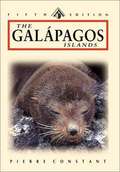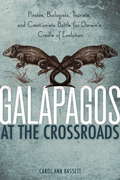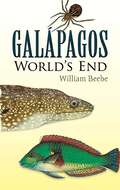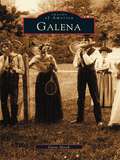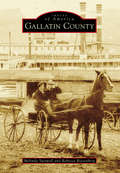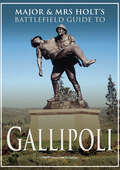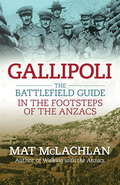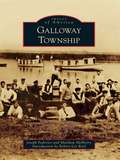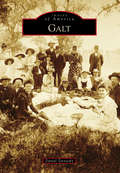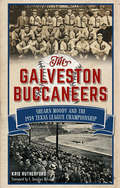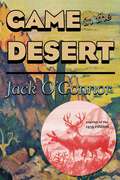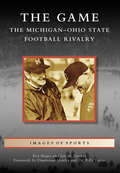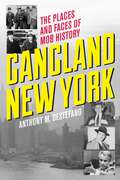- Table View
- List View
Galapagos Islands: A Natural History Guide
by Pierre ConstantThe wildlife paradise of the Galapagos Islands, long regarded as a mysterious and desolate spot, is a showcase of evolution in action. A spawning ground for Charles Darwin's famous theory, the islands have become a National Park dedicated to the conservation of many unique species threatened with extinction. Pierre Constant provides detailed descriptions of the geology and natural history of the archipelago, the visitors' sites, as well as the spectacular sea and land birds, peculiar reptiles, playful mammals and amazing marine life that make their homes there.
Galapagos at the Crossroads: Pirates, Biologists, Tourists, and Creationists Battle for Darwin's Cradle of Evolution
by Carol Ann BassettAre the Galapagos really more special than other places? Or are they one example of many microcosms that exist on this fragile planet we call home? I had to conclude that they are unique. Scientists have now said farewell to the Holocene and have rung in a new epoch. They've dubbed it the Anthropocene--a human dominated age in which urban-industrial society has contributed to global warming, mass extinctions, the displacement of species and cultures, and the depletion of non-renewable resources. The impacts, they say, are permanent; the course of evolution itself has been thrust into the unknown.
Galapagos: World's End
by William Beebe"Galápagos is a glorious book. It is high romance, exact science, fascinating history, wild adventure."--NationThe Galápagos Islands are famed for their remarkable wildlife, including land and marine iguanas, land tortoises, four-eyed fish, and flightless cormorants and albatross. In 1835, Charles Darwin observed variations among the islands' species that inspired him to formulate the theory of natural selection. Eighty-eight years later, in 1923, a scientific expedition sponsored by the New York Zoological Society followed in Darwin's wake. Led by renowned biologist and explorer William Beebe, the scientists visited the the islands to study and obtain specimens of indigenous plants and animals. This is Beebe's personal account of that fascinating expedition.Combining rare literary skill with careful research, Beebe produced an exceptionally readable volume, replete with youthful enthusiasm, a romantic's awe before the mysteries of nature, and a scientist's passion for accurate description. He recounts the expedition's enormously productive results, including specimens of 60 species previously unknown to science, and an unparalleled accumulation of data that stimulated many scientific papers and new avenues of naturalistic inquiry. Beebe's account is enhanced with more than 100 splendid illustrations, selected from hundreds of paintings, drawings, and photographs by expedition members. A classic of popular science, it is scientifically rigorous as well as exciting and accessible.
Galena: A Brief History (Images of America)
by Diann MarshGalena, IL, nestled in the bluffs of the Mississippi River in northwest Illinois, is one of the most historic communities in the region. The townspeople take pride in the rich history of their town, dedicating their time to restoration projects and the booming industry of heritage tourism. In this book you will meet the town's pioneer residents, stroll the historic business district, and discover the unique architecture of Galena. Many of the images (c. 1826-1940s) in the book come from the Galena/Jo Daviess Historical Museum (which is sponsoring the project), the Alfred Mueller collection, the Illinois Historic Sites Office, and private collections.
Gallatin County (Images of America)
by Melinda Sartwell Rebecca RiesenbergTucked away on the banks of the Ohio River, Gallatin County is a hidden gem that embodies the essence of historic Kentucky regions. Formed in 1798, the county boasted a desirable combination of rolling farmlands and favorable river frontage that was vital for early pioneers as they moved west to settle the frontier. The county's location along river and shipping routes between Cincinnati and Louisville provided both a bustling economy and a rural lifestyle for its residents. The decline in river traffic and the construction of Interstate 71 in the 1960s largely left the county behind and dramatically impacted the local economy. As homage to its pioneering roots, Gallatin County has revitalized its economy with a busy marina, two major employers (Gallatin Steel and Dorman Products), and the spectacular Kentucky Speedway while retaining its rural historical charm.
Gallipoli: Battlefield Guide (Major and Mrs Holt's Battlefield Guides)
by Tonie Holt Valamai HoltThis illustrated guide includes a historical overview of the battle, maps, itineraries, and updated information on memorials, museums, and more. The Battle of Gallipoli was one of the most bitterly fought conflicts of the Great War, and a profound and tragic loss for Entente powers of Britain, France, and Russia. This guidebook to the battlefields and historic sites of Gallipoli is an invaluable asset for any visitor who hopes to get the most out of their trip. Along with complete and updated information on museums, memorials, and war cemeteries, Major and Mrs. Holt provide essential historical overviews and practical itineraries covering all of the battleground sites. FULLY UPDATED
Gallipoli: Battlefield Guide (Major and Mrs Holt's Battlefield Guides)
by Tonie Holt Valamai HoltThis illustrated guide includes a historical overview of the battle, maps, itineraries, and updated information on memorials, museums, and more. The Battle of Gallipoli was one of the most bitterly fought conflicts of the Great War, and a profound and tragic loss for Entente powers of Britain, France, and Russia. This guidebook to the battlefields and historic sites of Gallipoli is an invaluable asset for any visitor who hopes to get the most out of their trip. Along with complete and updated information on museums, memorials, and war cemeteries, Major and Mrs. Holt provide essential historical overviews and practical itineraries covering all of the battleground sites. FULLY UPDATED
Gallipoli: The battlefield guide
by Mat MclachlanThe essential travel companion for anyone visiting Gallipoli.Each year, thousands of Australians visit Gallipoli to pay homage and see where their forebears fought, suffered and died. Anzac Cove, Quinn's Post, Lone Pine - the iconic places where our national legend was forged.In this essential and authoritative guide, practical information is combined with historical detail, alongside revealing and often heartrending quotes from the letters and diaries of the Anzacs themselves.- Detailed easy-to-follow plans for walking and driving tours across the main battlefields- Maps, photos and historical commentary to put the campaign in context- Everything you need to know where to go, where to stay and how to get there.Walk where the Anzacs walked, see where they fought and marvel at their courage.
Galloway Township
by Joseph Federico Matthew Mchenry Robert Lee ReidGalloway Township, founded in 1774 by the royal patent of King George III, is the largest municipality in New Jersey, encompassing the Absecon Highlands, Cologne, Conovertown, Germania, Higbeetown, Leeds Point, Oceanville, Pinehurst, Pomona, Smithville, and South Egg Harbor. Galloway has experienced everything from pirates to Prohibition. The Battle of Chestnut Neck occurred in Galloway in 1778 during the American Revolution. Along the way, the township has become home to Historic Smithville and Village Greene, the Seaview Resort, and the Noyes Museum of Art and has become the supposed birthplace of the fabled "Jersey Devil."
Galt (Images of America)
by Daniel TarnaskyNew York native Dr. Obed Harvey came to California to seek his fortune in the Gold Rush. Like so many others, he turned to farming the great Central Valley. With the help of the Central Pacific Railroad, Dr. Harvey established a town around the railroad that ran through his property. His friend John McFarland, a rancher, chose the name Galt after his boyhood home in Canada. Over the years, unique businesses like the Sego Milk Plant and the Galt Winery came and went. The citizens celebrated the Fourth of July with parades and attended the Sacramento County Fair, held in town. Still a farming community with a small-town atmosphere, Galt is noted for Spaans Cookie Co., McFarland Living History Ranch, and the Rae House Museum.
Galveston Buccaneers, The: Shearn Moody and the 1934 Texas League Championship (Sports)
by Kris Rutherford E. Douglas McleodGalveston survived the Great Depression with a healthy dose of baseball, boll weevils and bootleg business. Farmers like future Galveston Buccaneers star Buck Fausett fled the insect infestation of North Texas for the city's sunny shores along with throngs of visitors eager to visit Sam Maceo's clubs and catch a ballgame. Galvestonians had a long love affair with America's favorite pastime, fielding the first game played in the state. Cotton heir Shearn Moody purchased the Buccaneers in 1931 and turned the languishing squad into a dominating force that won the 1934 Texas League Championship. Author Kris Rutherford weaves a captivating history of the Moody family, a team of talented players and the island that claimed them.
Galveston Seawall Chronicles (Landmarks)
by Kimber FountainAlong Galveston's Gulf Coast runs a seventeen-foot-high, ten-mile-long protective barrier--a response to the nation's all-time deadliest natural disaster. The seawall remains a stoic protector more than a century later, shielding the island from much more than physical destruction. As the foundation of Seawall Boulevard, this structure created an entirely new tourism industry that buoyed the city's economy through war, the Great Depression and hurricanes. Adapting to the cultural trends and political movements that defined the past century, the seawall represents the unbreakable spirit of Galveston's resilient population and provides a fascinating glimpse into bygone times.
Galveston’s Historic Downtown and Strand District
by Denise AlexanderThe Strand, known as the Wall Street of the Southwest, contains a significant collection of 19th-century buildings. Long the center of Galveston's business community, its architecture is a reminder of this historic port city. The National Historic Landmark District includes buildings classified as Greek Revival, Italianate, and Victorian style--sometimes with traces of vernacular building traditions that date to the 1850s. Historic images found within this book illustrate the development of the Strand and surrounding streets, including Mechanic, Market, and Postoffice. Galveston's Historic Downtown and Strand District demonstrates the power of place, despite an ever-changing economy and natural disasters.
Galápagos Islands
by Ben WestwoodSea lions and iguanas sunbathe side by side, penguins and turtles swim together offshore, and giant tortoises wander freely. The Galápagos is both a glimpse of life before human civilization and a reminder of its fragile beauty. This is the trip of a lifetime. It will leave you with a new sense of wonder — and some great stories to share. Expert traveler Ben Westwood tells you everything you need to know to make this trip possible in Moon Galápagos Islands: How to get there, how long it will take, and where to stop along the way — including information on Quito and Guayaquil How to choose the best means of transportation, including cruises, diving tips, and land tours Background on the diverse wildlife of the Galápagos — including how and where to see each animal
Galápagos: A Natural History Second Edition
by Kevin Loughlin John C. KricherA richly illustrated nature tour of Galápagos—now expanded, thoroughly updated, and with more than 650 color photographsGalápagos is a comprehensive, up-to-date, and profusely illustrated natural history of this spectacular archipelago. Offering much more information than identification guides, the book provides detailed accounts and more than 650 color photographs of the islands’ habitats, marine life, reptiles, birds, mammals, and plants, making the book a virtual nature tour of Galápagos.Galápagos experts John Kricher and Kevin Loughlin have thoroughly revised the original text, bringing all the taxonomy up to date and adding a wealth of new information. Individual chapters cover geology, ecology, human history, Darwin’s finches and how Darwin came to his theory of natural selection from his visit to the islands, Galápagos tortoises, marine and land iguanas, mammals, seabirds, landbirds, marine life, and conservation challenges and initiatives. The concluding chapter covers each of the individual islands, including landing sites, unique plant and animal species, and points of interest, and serves as a wonderful guide for visitors as they move from island to island or plan a trip to Galápagos.With its combination of rich text and splendid photos, Galápagos is essential reading for the ecotraveler and nature enthusiast alike.Now with more than 650 color photographs, showing habitats, geology, marine life, and all the commonly encountered reptiles, birds, mammals, and plantsFeatures a detailed island-by-island guide, including landing sites and what visitors can expectEssential reading for the ecotraveler and nature enthusiast
Game in the Desert
by Jack O'ConnorThis book—a reprint of the original 1939 edition—offers an in-depth look at some of the most sought-after game in the American Southwest and northern Mexico. Included are black and grizzly bears, doves, elk and deer, and even Mexican jaguars. Each animal-dedicated chapter details habitat and behavior and includes stories from the author. Based mostly on the author&’s observations of game while on the hunt or just exploring in the field, this classic is a departure from natural history books that &“are simply a rehash of other books that are a rehash of still other books.&”
Game, The: The Michigan-Ohio State Football Rivalry (Images of Sports)
by Ken Magee Jon M. Stevens Dr Billy Taylor Dimitrious StanleyWith a history that stretches over a century, the Michigan-Ohio State rivalry is one of the oldest in college football. The two teams claim a combined 19 national championships, hundreds of All-Americans, and 10 Heisman Trophies. Each year, millions of Buckeye and Wolverine fans watch the two teams battle for an opportunity to win the Big Ten championship in a contest simply known as "the Game."
Gamecock Glory: The University of South Carolina Baseball Team's Journey to the 2010 NCAA Championship (Sports)
by Travis HaneyAfter more than one hundred years of craving a champion, the University of South Carolina finally has one. The 2010 Gamecock baseball team won six consecutive games over eight summer nights to take the College World Series and lay claim to the school's first major national championship. From dancing around in a dark locker room to singing "Silent Night"? on the team bus after every victory in Omaha, these Gamecocks were as fun-loving as they were talented. And they did it all in the name of one special boy, seven-year-old Bayler Teal. Bayler passed away before he could see his beloved Gamecocks triumph, but the team's victory is a tribute to their number one fan. Join the Post and Courier's Travis Haney as he recounts this incredible team's historic season.
Gangland New York: The Places and Faces of Mob History
by Anthony M. DeStefanoGet a taste of New York&’s underworld by seeing where mobsters lived, worked, ate, played, and died. From the Bowery Boys and the Five Points Gang through the rise of the Jewish &“Kosher Nostra&” and the ascendance of the Italian Mafia, mobsters have played a major role in the city&’s history, lurking just around the corner or inside that nondescript building. Bill &“the Butcher&” Poole, Paul Kelly, Monk Eastman, &“Lucky&” Luciano, Carlo Gambino, Meyer Lansky, Mickey Spillane, John Gotti—each held sway over New York neighborhoods that nurtured them and gave them power. As families and factions fought for control, the city became a backdrop for crime scenes, the rackets spreading after World War II to docks, airports, food markets, and garment districts. The streets of Brooklyn, swamps of Staten Island, and vacant lots near LaGuardia Airport hosted assassinations and hasty burials for the unlucky. The bloodlettings, arrests, and trials became front-page fodder for tabloids that thrived on covering Mulberry Street. Chinese, Russian, and Greek mobsters rose to prominence and wrought bloody havoc as well. Each of the book&’s five sections—one for each borough—traces criminal activities and area exploits from the nineteenth century to now. Everyone knows about Umberto&’s Clam House in Little Italy, but now you can find Scarpato&’s restaurant in Coney Island where Joe Masseria was killed by henchmen of Salvatore Maranzano, who in turn died in a Park Avenue office building at the hands of &“Lucky&” Luciano a few months later. From the Bronx to Brighton Beach, from New Springville to Ozone Park, here is a comprehensive, on-the-ground guide to mob life in the Rotten Apple.
Gap Year Adventures: An Essential Pocket Guide to Making It Count
by Tamsin KingGap years are bursting with possibility, begging to be filled with new experiences and unforgettable moments. But how do you make the most of your time out? This handy guide is packed with exciting and creative ideas. Whether you’re in search of a thrilling outdoor activity or a spiritual awakening, here’s how to make it truly memorable.
Gap Year Adventures: An Essential Pocket Guide to Making It Count
by Tamsin KingGap years are bursting with possibility, begging to be filled with new experiences and unforgettable moments. But how do you make the most of your time out? This handy guide is packed with exciting and creative ideas. Whether you’re in search of a thrilling outdoor activity or a spiritual awakening, here’s how to make it truly memorable.
Gap Year Girl: A Baby Boomer Adventure Across 21 Countries
by Marianne C. BohrIn the 1960s and ’70s, thousands of baby boomers strapped packs to their backs and flocked to Europe, wandering the continent on missions of self-discovery. Many of these boomers still dream of “going back”—of once again cutting themselves free and revisiting the places they encountered in their youth, recapturing what was, and creating fresh memories along the way. Marianne Bohr and her husband, Joe, did just that. In Gap Year Girl, Bohr describes what it’s like to kiss your job good-bye, sell your worldly possessions, pack your bags, and take off on a quest for adventure. Page by page, she engagingly recounts the experiences, epiphanies, highs, lows, struggles, surprises, and lessons learned as she and Joe journey as independent travelers on a budget—through medieval villages and bustling European cities, unimaginable culinary pleasures, and the entertaining (and sometimes infuriating) characters encountered along the way. Touching on universal themes of escape, adventure, freedom, discovery, and life reimagined, Gap Year Girl is an exciting account of a couple’s experiences on an unconventional, past the-blush-of-youth journey.
Garbology: Our Dirty Love Affair with Trash
by Edward HumesA Pulitzer Prize-winning journalist takes readers on a surprising tour of America's biggest export, our most prodigious product, and our greatest legacy: our trash <P><P> The average American produces 102 tons of garbage across a lifetime and $50 billion in squandered riches are rolled to the curb each year. But our bins are just the starting point for a strange, impressive, mysterious, and costly journey that may also represent the greatest untapped opportunity of the century. <P> In Garbology, Edward Humes investigates trash--what's in it; how much we pay for it; how we manage to create so much of it; and how some families, communities, and even nations are finding a way back from waste to discover a new kind of prosperity. Along the way , he introduces a collection of garbage denizens unlike anyone you've ever met: the trash-tracking detectives of MIT, the bulldozer-driving sanitation workers building Los Angeles' Garbage Mountain landfill, the artists residing in San Francisco's dump, and the family whose annual trash output fills not a dumpster or a trash can, but a single mason jar.<P> Garbology reveals not just what we throw away, but who we are and where our society is headed. Waste is the one environmental and economic harm that ordinary working Americans have the power to change--and prosper in the process.<P> Garbology is raising awareness of trash consumption and is sparking community-wide action through One City One Book programs around the country.<P> It is becoming an increasingly popular addition to high school and college syllabi and is being adopted by many colleges and universities for First Year Experience programs.
Garden Cemeteries of New England
by Trudy Irene SceeIn 1831 a new entity appeared on the American landscape: the garden cemetery. Meant to be places where the living could enjoy peace, tranquility and beauty, as well as to provide a final resting place for the dead, the garden cemeteries would forever change the culture of death and burial in the United States. The ideal cemetery would become one in which ornamental trees, bushes, flowers, and waterways graced the ever more artistic (for those who could afford them) monuments to the dead. Previous to the 1830s, the deceased were buried in church lots, in small and soon overcrowded public lots, and even, occasionally in backyards and fields. Graves were often untended, weeds and decay soon took over, and the frequently used wooden grave markers rotted away. Some turned to a movement emerging in Europe, in which horticulture was starting to become a factor in cemetery planning, at a time in which cemetery planning itself was a novel idea. New England was the first region in America to take up the new ideals.The first such cemetery, Mt. Auburn, opened in Cambridge, Massachusetts, in 1831, and Mount Hope Cemetery, in Bangor, Maine, followed in 1834. Today, these cemeteries are both beautiful places to visit and important historical sites. The author takes readers on a historical tour of eighteen of the Northeast's garden cemeteries, exploring the landscape architecture, the stunning beauty, and delving into the rich history of both the sites and of those who are buried there.
Garden State Parkway (Images of America)
by The New Jersey Turnpike AuthorityThe Garden State Parkway has transformed the lives of New Jersey residents since opening in 1954. Spanning 173 miles from Cape May to the New York State line, it has fostered tourism to the Jersey Shore and given commuters an easier way to get to work. Gov. Alfred E. Driscoll had envisioned the impact a new highway could have on the state, and a large team of planners, engineers, and contractors made it happen. In 1952, the legislature created the New Jersey Highway Authority to ensure the funding and completion of the $330-million parkway and to self-sufficiently operate the roadway through toll revenue. Garden State Parkway shows how this iconic roadway gained its place in history and continues to combine safe transportation in a parklike setting with the scenic beauty of New Jersey.
